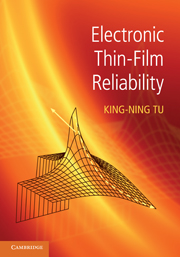Book contents
- Frontmatter
- Dedication
- Contents
- Preface
- 1 Thin-film applications to microelectronic technology
- 2 Thin-film deposition
- 3 Surface energies
- 4 Atomic diffusion in solids
- 5 Applications of the diffusion equation
- 6 Elastic stress and strain in thin films
- 7 Surface kinetic processes on thin films
- 8 Interdiffusion and reaction in thin films
- 9 Grain-boundary diffusion
- 10 Irreversible processes in interconnect and packaging technology
- 11 Electromigration in metals
- 12 Electromigration-induced failure in Al and Cu interconnects
- 13 Thermomigration
- 14 Stress migration in thin films
- 15 Reliability science and analysis
- Appendix A A brief review of thermodynamic functions
- Appendix B Defect concentration in solids
- Appendix C Derivation of Huntington's electron wind force
- Appendix D Elastic constants tables and conversions
- Appendix E Terrace size distribution in Si MBE
- Appendix F Interdiffusion coefficient
- Appendix G Tables of physical properties
- Index
- References
11 - Electromigration in metals
Published online by Cambridge University Press: 05 July 2014
- Frontmatter
- Dedication
- Contents
- Preface
- 1 Thin-film applications to microelectronic technology
- 2 Thin-film deposition
- 3 Surface energies
- 4 Atomic diffusion in solids
- 5 Applications of the diffusion equation
- 6 Elastic stress and strain in thin films
- 7 Surface kinetic processes on thin films
- 8 Interdiffusion and reaction in thin films
- 9 Grain-boundary diffusion
- 10 Irreversible processes in interconnect and packaging technology
- 11 Electromigration in metals
- 12 Electromigration-induced failure in Al and Cu interconnects
- 13 Thermomigration
- 14 Stress migration in thin films
- 15 Reliability science and analysis
- Appendix A A brief review of thermodynamic functions
- Appendix B Defect concentration in solids
- Appendix C Derivation of Huntington's electron wind force
- Appendix D Elastic constants tables and conversions
- Appendix E Terrace size distribution in Si MBE
- Appendix F Interdiffusion coefficient
- Appendix G Tables of physical properties
- Index
- References
Summary
Introduction
In Chapter 1, Section 1.2, we discussed the operation of a metal-oxide-semiconductor FET. There are hundreds of millions or even billions of such transistors on a Si chip the size of a fingernail. To interconnect all these transistors by VLSI circuit technology, multilayers of thin-film interconnect wires made of Al or Cu were used. Electromigration is the most serious and persistent reliability problem in the interconnect structure on a Si chip in microelectronic technology. This is because typically a current density of 105 to 106 A/cm2 is conducted by the thin-film wires. Under such high current density, atomic diffusion and rearrangement are enhanced, leading to void formation in the cathode and extrusion in the anode of an interconnect. The void can become an open and the extrusion a short in the circuit. On the other hand, it is worth mentioning that there is no electromigration in an ordinary extension cord used at home and in laboratories. The electric current density in the cord is low, about 102 A/cm2, and also the ambient temperature or room temperature is too low for atomic diffusion to occur in the copper wire in a cord.
The free electron model of conductivity of metals assumes that the conduction electrons are free to move in the metal, unconstrained by the perfect lattice of atoms except for scattering due to phonon vibration and structural defects such as grain boundaries, dislocations, and vacancies in the lattice. The scattering is the cause of electrical resistance and joule heating.
- Type
- Chapter
- Information
- Electronic Thin-Film Reliability , pp. 237 - 269Publisher: Cambridge University PressPrint publication year: 2010



